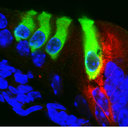RasGRF1 disruption causes retinal photoreception defects and associated transcriptomic alterations.
الكلمات الدالة
نبذة مختصرة
RasGRF1 null mutant mice display impaired memory/learning and their hippocampus transcriptomic pattern includes a number of differentially expressed genes playing significant roles in sensory development and function. Odour avoidance and auditory brainstem response tests yielded normal results but electroretinographic analysis showed severe light perception impairment in the RasGRF1 knockouts. Whereas no structural alterations distinguished the retinas of wild-type and knockout mice, microarray transcriptional analysis identified at least 44 differentially expressed genes in the retinas of these Knockout animals. Among these, Crb1, Pttg1, Folh1 and Myo7a have been previously related to syndromes involving retina degeneration. Interestingly, over-expression of Folh1 would be expected to result in accumulation of its enzymatic product N-acetyl-aspartate, an event known to be linked to Canavan disease, a human cerebral degenerative syndrome often involving blindness and hearing loss. Consistently, in vivo brain nuclear magnetic resonance spectroscopy identified higher levels of N-acetyl-aspartate in our RasGRF1-/- mice and immunohistochemical analysis detected reduced levels of aspartoacylase, the enzyme which degrades N-acetyl-aspartate. These studies demonstrate for the first time the functional relevance of Ras signalling in mammalian photoreception and warrant further analysis of RasGRF1 Knockout mice as potential models to analyse molecular mechanisms underlying defective photoreception human diseases.


